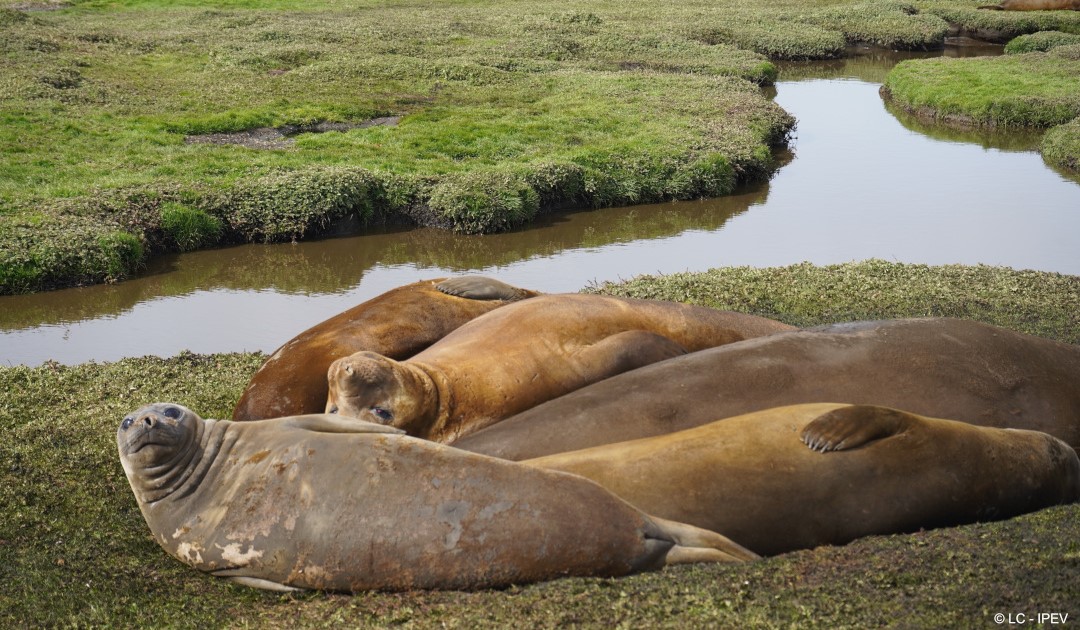
Southern elephant seals don’t fast completely during the drastic moulting period, but they could very well go in the water, drink and maybe even hunt, contrary to what has been established so far.
The widespread idea of southern elephant seals fasting on the beaches of the Southern Ocean during their moult has become inaccurate since the publication of a study by Laura Charlanne and colleagues in Communication Biology on January 8. After a long period of observation, biologists confirm that some females go out to sea during the moult, “up to 30 kilometers from the coast for the one that went furthest”, explains Laura Charlanne, a PhD student at Strasbourg’s Institut Pluridisciplinaire Hubert Curien.
This calls into question the basic assumption that it is more expensive for molting elephant seals to maintain their bodies at 36°C in seawater than on the beach, where they would stay to save themselves. “It’s the most energy-intensive time of the year, as they renew their skin and fur,” she explains. To achieve this, they maintain a high level of blood circulation around their bodies to stimulate cell growth.

During this blood flow, heat loss is significant. “When it’s cold, our extremities turn white, a sign of vasoconstriction, which limits heat loss,” she reminds us. Outside, the temperature is much lower than their body temperature.
Despite this, females go into the water and may even hydrate themselves. The research team notes that they submerge when there is less wind, higher temperature and stronger insolation. “We can assume they’ll cool off,” comments Laura Charlanne.
To be sure, the authors would have liked to observe a “heat stroke” in the internal sensors ingested by the animals, but “we didn’t see any hyperthermia”, she adds, questioning the measuring device. In 2017-2018, Laureline Chaise (co-author) had shown that the distribution of molting elephant seals in habitats around beaches – earth holes, dumps and grass – as well as aggregations of individuals, depended on environmental variables such as temperature.
Not only do elephant seals go in the water, they also dive, sometimes up to 20 meters, and “their dives are like hunts”, describes Laura Charlanne. They swallow water and perhaps prey as well as hydrating themselves. “Their regulation system is adapted,” says the researcher, “these animals have already been observed drinking seawater or freshwater.” But they mainly hydrate themselves with the water contained in their fat reserves accumulated while hunting at sea.


“On days when it was warm, we found some in the water, but it was difficult to see their moult stage, because when wet, you can’t distinguish between old and new skin,” explains Batshéva Bonnet, a veterinarian on mission for this study in 2017 on Kerguelen. This is why the females were also fitted with beacons to track their movements. Teams carried out daily visual checks to recover the beacons before they returned to sea at the end of the moult.
This complete renewal of the epidermis and short hair remains a bit of a mystery, as does the purpose of the fur. “Do they act as thermal insulators? Does it protect them from the salt when they swim? In any case, they lose hair and epidermis, which is why we speak of a drastic moult,” explains Laura Charlanne.
It is the only species of this pinniped family to undergo this moult in a polar environment. An environment that is changing “drastically” due to climate disruption. “For the time being, there are no consequences for their body condition at the end of the moult. These are very important conditions for swimming effort, buoyancy and hunting success over the next six months,” she adds.
Camille Lin, PolarJournal
Find out more about this topic:





